
Physics versus Playability

Only thrusters which are visible on the model may be used, anything too small to see would not provide anything more than local manouvering capabilities. This requires SCS changes to remove the front and side thrusters
Thrusters are a form of ion engine using reaction mass kept nearby and ionised using power from the reactor. This ionised mass is then accelerated out of the back again using power from the reactor. The concept of a separate engine creating the thrust does not exist, each thruster is considered an engine. There is no single central engine supplying ionised reaction mass to both ends of an Omega.
When a ship has lost half it's sides it will only pivot at half the normal rate.
As soon as enough total power has been provided over a number of rounds the ship changes speed.
No other manouevres requiring thrust may be made during this period.
In the next turn the full distance is travelled as your speed would be 4 for the complete turn.
Thrusters are not generally be capable of putting much more than the the recommend thrust through them. In war ships the safety margin for a non-critical system (you generally have multiple thrusters) would be considerably less than a civilian ship.
There are currently no rules allowing overthrusting.
Both the Minbari and Centauri are shown to have gravity aboard their ships. Capital ships use gravitic engines in preference to reaction thrusters. Minbari capital ships do not show thrusters on the show. Gravitic engines generate both the main thrust and the gravity within the ship. The power required to produce enough gravity to move a ship is very high so smaller ships and less technically advanced races often use normal ion engines to move and the gravitic engines to provide gravity only.
All Minbari Capital ships and HCVs have their thrusters replaced with a single gravitic engine capable of providing thrust in any direction. Smaller ships have a small gravitic engine which if destroyed causes the ship to go zero G giving it a -5 on iniative for the rest of the battle.
Where gravitic engine provides thrust each damaged box reduces thrust by 1 point.
Enormous units do not fully occupy a hex, only moons of 100 miles diameter and larger bodies prevent entrance to the hex as the battle is assumed to be on the line of the equator.
No ships can turn on a sixpence at any normal speed, instead rather like a ship they must plan their turns in advance. Whether playing with or without side thrusters, in order to turn a ship must pivot then fire their rear thrusters. This will not cause an instant change of direction, instead the ship will continue travelling forward for a significant period whilst slowly starting to move in the direction desired.
Unlike the sea where a sideways force can be applied by a rudder in space the only thing that can cause a ship to change direction is thrust and in order to apply this thrust the ship must be pointing in the correct direction. What actually happens is that the ship pivots past the turn angle to apply the thrust then pivots back again. If this didn't happen the ship would still be travelling forward at the same speed and simply move sideways as well.
The turn delay of a ship simulates the distance the ship will carry on forward whilst it pivots and aplies thrust.
This is illustrated in figure 1 'Actual ship course'. Here the actual path travelled in red is simulated in green by the path on the hex map. The captain who has a turn delay of 6 gives the order to start the manoeuvre at point -3, in normal play the ship would turn immediately however in reality the effective turning point is at point 0 and the finishing point before he can turn again is at point +3. Half the turn delay is before the turn point as marked on a board, the other half is after.
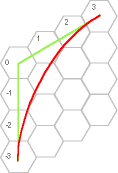
|
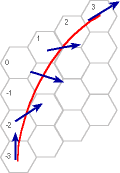
|
| Actual ship course | Ship pivot during turn |
|---|
Turn delays should be based on the acceleration the ship can provide and the speed with which it can pivot to apply the thrust in the correct direction.. To make a playable game the calculated delays have ignore the time to pivot and been divided by three, this brings the delays down to a playable figure. Even though pivot times have been ignored agile ships and gravitic drive ships receiving a bonus as they can apply the thrust in the correct direction faster then normal ships and don't lose the benefit of their technology.
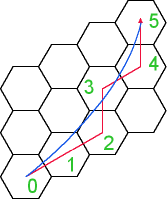
|
| 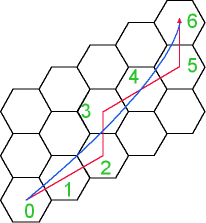 | ||||||||||||||||||
|---|---|---|---|---|---|---|---|---|---|---|---|---|---|---|---|---|---|---|---|---|
| Speed 5 - slides 2 | Speed 6 - slides 2 |
Rolls use the manoeuvring thrusters only for which thrust is not tracked. Loss of a side or end has no effect
In the show (The fall of night) the Primus from the front hits the rear of the G'Quon. This is because in 3 dimensions most of a target will usually be the top or bottom of a ship and you have an good chance to strike any part of that surface, front, side or rear.
When a hit has been rolled the attacker rolls a d10 to determine the side that was hit
Some weapons due to their placement may not be hittable from the directly oposite side. These are marked with an asterisk on the location chart. Hits rolled to these locations strike the structure instead. This replaces the restriction on only being able to strike weapons who's arc you are in.
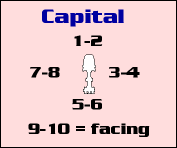
|  |

|
This gives a 40% chance of hitting the nearest side of a capital ship and a 20% chance of any other side. Specific ships may have different values to those above due to their configuration.
Unless turning ships at range 0 are actually overflying one another. This gives both craft the opportunity to attack with weapons on both sides of their ship as they fly past. This requires the combat turn to break down into two sub-phases at zero range, one for the weapons on approach and one after the pass-over.
The weapons in arc are determined by the relative velocities of the ships. The ship travelling faster will have the slower ship in its forward arc, whilst the lower ship will have the faster ship in the arc equal to its position as it entered the hex. As the ships pass over each other the opposite arcs will come into affect. If both ships are travelling at the same speed then both are in the arc relative to their position as they enter the hex.
This is ignored. The first ship to be moved into the hex may only fire weapons that point in the direction of approach of the other ship. The second ship to arrive may only fire weapons that were facing the target hex as it approached (normally this would be the forward firing guns but it may be pivoted)
The effective range should include the speed of the ship as it has free velocity in the ships direction. The effective launch position is where the ship would be at the of the round if it didn't change course.
Missiles don't get strap on boosters depending upon which rack they are fired from and any form of explosion charge to give an initial boost is unlikely to fire the missile in the right direction, missiles tend to be fired with compressed gas to clear the launcher then ignite motors and change direction to head towards the target, any additional instantaneous boost would have minimal overall effect on the missiles speed.
There is no additional "chase" range. Racks do not provide either a range bonus.
Missile racks do not contain a sensor suite so cannot give a fire control bonus, ballistics are either guided using the main ships sensors (torpedoes) or from internal systems (missiles). It's feasible (just) that the missile rack may contain communication equipment specific to the torpedoes launched from it,
Torpedoes need to be in arc at the point of impact to gain the sensor bonus.
Missiles use their internal sensors and do not need to be in arc.
When attempting to hit a specific system or weapon on a ship the difficulty is constant regardless of the size of the ship aimed at. An interceptor is the same size on an Omega as it is on a police cutter. Each weapon is given a specific defence signature appropriate to its size. The guideline value for such items is
| System | Signature |
|---|---|
| Anti-fighter weapon | -3 |
| Main weapon | -1 |
| System | 0 |
Systems include hangers, thrusters and other non-weapons.
Weapons tend to be near the edge of a ship so when aiming at specific weapons there is roughly 50% chance of hitting the ship with a miss. Called shots which miss by 1 are assumed to have hit the structure next to the system aimed at.
Different weapons should have different rake values dependent upon the size and power of the beam. when comparing heavy and light lasers the heavy laser is either more intense, wider beam or lasts longer. Shots that last longer are sustained shots, bigger weapons on the other hand cause more damage for each second they are on the target.
This is simulated by applying different rake values to each weapon
| Weapon | Rake value |
|---|---|
| Light laser | 8 |
| Medium laser | 10 |
| Combat laser | 11 |
| Battle laser | 11 |
| Heavy laser | 12 |
| Neutron cannon | 12 |
| Improved Neutron cannon | 13 |
Interceptors intercept by putting a lot of fire in the way of incoming fire, this does not equate to a lower signature as that can make a ship impossible to hit at low signatures or have no effect at high signatures. Each intercepting weapon has a chance to hit incoming fire, normally 1 in 10.
All intercepting of shots is done on a chance to hit the shot. All intercepting weapons roll seperately. Specialised interceptor weapons get higher interception ratings.
Interception is handled automatically by the targeting computers, they will only attempt to hit shots on target. After determining which shots from a given weapon will hit the defending captain decides which weapons to intercept based on the attack. Any non-assigned interception weapons may be carried over onto future attacks fired that round but may not be back dated if there are found to be spare shots left at the end of the round.
The interception attempt is rolled on a d10
The Mark II Interceptor is fired with an interception rating of 3
A 2 is rolled so 2 pulses are stopped
Fighters are very small fast moving hard to hit craft. This leads to many deficiencies compared to their larger brethren. They use miniscule amounts of EW compared to capital ships, have no armour, virtually no structure, and guns that have little effect on heavily armoured systems. Fighters are there to strip the defensive weapons and external systems from the mainline ships to allow the big guns to reach the ship's internal systems and remove the offensive threat. Fighters cannot do significant damage to a ships structure.
Fighters are shown to use OEW in two different ways.
Any computer system that tracks a ship will be just as affected by DEW as a normal ship would. otherwise they would install the fighters tracking system on a ship to negate the enemy's defensive EW.
Fighters have some serious advantages however, being small they are very hard to hit and being able to get up close (500m or so) they can eyeball their targets if their EW systems are being jammed either by Minbari jammers or plain DEW.
e.g.
Flight A has fighters 2,3,5,6 remaining
Flight B hits 3 times.
The defender rolls a 4 on a d6 and selects fighter 4 as the starting point. Fighter 4 however has already been killed so the first shot hits fighter 5, the second shot fighter 6 and the third wraps around to fighter 2.
Fighters are usually given assignments by their base ship and then allowed to carry out their mission however they see fit. During a game, at the beginning of the initiative phase, before any ships have rolled for initiative, fighter flights may be issued orders that they will carry out for this turn.
With this order the fighters are assigned a ship in the fleet to protect from other crraft. The flight may freely engage any enemy craft that moves within 2 hexes of the designated vessel. This is counted as a counter-intercept. Note- it must be declared to the opposing player at the beginning of the initiative phase which one of his flights is flying a CAP for which ship. The patrol flight always move at the end of the round and may only fire on targets within the patrol range (2 hexes).
With this order the fighter flight is assigned the task of intercepting a specific unit of enemy fighters. The fighters given this mission must engage the designated fighter flight or move as close to them as possible if they are out of reach. Note- it must be declared to the opposing player which one of his flights is targeted in this way. The interceptors always move after their target squadron.
Sensors may not take an infinite amount of power through them without burning up, indeed they will be operating at near the maximum capability most of the time, much more power than they are designed for will simply burn out the circuits.
Sensors rely on external aerials
Sensors may not be boosted
If a side or end of a ship is destroyed the sensors original power is reduced, Capitals lose 25% per side, HCVs and smaller 50%.
You don't automatically lose the use of power from a reactor just because an external weapon has been destroyed. The power is still being generated but there may be problems in routing it to a given area because of destroyed junction boxes or busbars. Also all sorts of shorts and circuit failures would happen with a hit which aren't modeled.
JMS stated that his universe did not have shields (at least before Thridspace aliens). The e-web was a cgi glitch explained away by a spur of the moment ill-considered idea (which was later retracted, but that doesn't get around much). Also why does the Whitestar have shields we never saw in action
Shields have been removed from all non-first one ships and the interceptor e-web modifiers disappears. In some cases these are replaced by stealth technology.
In trying to determine who has won (or lost the least) in a particular engagement counting up the costs of ships destroyed is only part of the answer. We must also include ships disengaged and ships captured by the other side. Ships disengaged only need time and some money to be repaired and return to the fighting. Ships destroyed lose both the full value of the ship and that of the crew. Ships captured lose the ship and crew value plus give the benefit to the opposing side of the ship value and propoganda.
This can be represented by a BPV multiplier for each ship. Each side scores for the opposing ships disengaged, destroyed or captured.
| Condition | BPV multiplier |
|---|---|
| Disengaged | x1 |
| 1/2 Damaged | x1 |
| Destroyed | x3 |
| Captured | x5 |